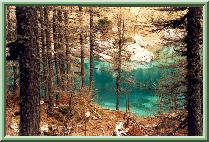 6th Triglav lake.
Just after its founding, the Triglav national park
was first limited to the valley of the seven Triglav lakes that
follow one another in a neat sequence in a gentle slope of a few
kilometres length. Today, this valley forms the core of a larger
area which is protected as a territory of special national importance.
The seven small lakes always fascinated people by their incredible
green-blueish colour. Sadly, especially the 6th (shown here)
and the 5th Triglav lakes that lie near the main mountain
hut, are already heavily polluted and I'm not sure how much of this
wonderful colour is still OK and how much is not. In any case,
bathing is already discouraged by the officials. The picture here,
however, was taken in late October, when the lake starts to rest
for a few months and recovers somewhat.
6th Triglav lake.
Just after its founding, the Triglav national park
was first limited to the valley of the seven Triglav lakes that
follow one another in a neat sequence in a gentle slope of a few
kilometres length. Today, this valley forms the core of a larger
area which is protected as a territory of special national importance.
The seven small lakes always fascinated people by their incredible
green-blueish colour. Sadly, especially the 6th (shown here)
and the 5th Triglav lakes that lie near the main mountain
hut, are already heavily polluted and I'm not sure how much of this
wonderful colour is still OK and how much is not. In any case,
bathing is already discouraged by the officials. The picture here,
however, was taken in late October, when the lake starts to rest
for a few months and recovers somewhat.
|
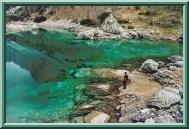 5th Triglav lake.
Another photo of
the nearby twin lake (you might call it a pond, but we
call it a lake, I suppose because it is so dear to us) and at about
the same time of year. The reflections on the water surface belong
to the ridge of Ticarica and Zelnarica that rise vertically a few
hundred metres just above the main valley. This (a bit brittle) ridge is
rarely visited, since the valley trail in the immediate vicinity of the
lakes attracts far more visitors. However, I can assure you that
the view from there is just plain great, despite the fact that
you have to dedicate some of it to pathfinding.
5th Triglav lake.
Another photo of
the nearby twin lake (you might call it a pond, but we
call it a lake, I suppose because it is so dear to us) and at about
the same time of year. The reflections on the water surface belong
to the ridge of Ticarica and Zelnarica that rise vertically a few
hundred metres just above the main valley. This (a bit brittle) ridge is
rarely visited, since the valley trail in the immediate vicinity of the
lakes attracts far more visitors. However, I can assure you that
the view from there is just plain great, despite the fact that
you have to dedicate some of it to pathfinding.
|
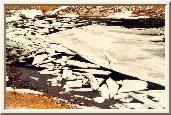 4th Triglav lake.
The 4th Triglav lake
(I really never figured it out in which
direction one should count them) is the largest lake in the Valley of the
seven lakes. It is also called `The Kidney' for its peculiar
kidney- or bean-like shape. The photo was taken somewhen in
April, when the snow slowly and ice start to melt. All Triglav lakes
freeze during the winter, when even the frequently visited valley
that holds them rests for a while. When winter and spring months
bring plenty of snow and rain, you might encounter some of the
footpath markings you used to see on the rocks you pass, under
transparent covers of water ice (but such winters became somewhat rare
these days...).
4th Triglav lake.
The 4th Triglav lake
(I really never figured it out in which
direction one should count them) is the largest lake in the Valley of the
seven lakes. It is also called `The Kidney' for its peculiar
kidney- or bean-like shape. The photo was taken somewhen in
April, when the snow slowly and ice start to melt. All Triglav lakes
freeze during the winter, when even the frequently visited valley
that holds them rests for a while. When winter and spring months
bring plenty of snow and rain, you might encounter some of the
footpath markings you used to see on the rocks you pass, under
transparent covers of water ice (but such winters became somewhat rare
these days...).
|
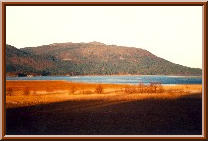 Cerknica lake.
The photo shows an intermittent lake
in the southwestern part of Slovenia.
The Cerknica lake has numerous underground sources and drains that
fill and empty the lake in a weird mechanism, event today only
partially understood. Our natural historian, scholar and explorer,
the baron J. Vajkard Valvasor, who accomplished most of his research
enterprises from the back of his horse, even became a member of the
Royal Society in London for studies of the complex mechanisms behind
this curious lake. Today, the Cerknica lake is maybe better known
for the neighbouring town of Cerknica and its Carnival, and for its
nearby mountain of Slivnica, where yelling witches ride their brooms
(not only for the Carnival). It is also popular among windsurfers.
Cerknica lake.
The photo shows an intermittent lake
in the southwestern part of Slovenia.
The Cerknica lake has numerous underground sources and drains that
fill and empty the lake in a weird mechanism, event today only
partially understood. Our natural historian, scholar and explorer,
the baron J. Vajkard Valvasor, who accomplished most of his research
enterprises from the back of his horse, even became a member of the
Royal Society in London for studies of the complex mechanisms behind
this curious lake. Today, the Cerknica lake is maybe better known
for the neighbouring town of Cerknica and its Carnival, and for its
nearby mountain of Slivnica, where yelling witches ride their brooms
(not only for the Carnival). It is also popular among windsurfers.
|
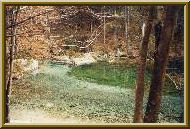 Source of Kamniska bistrica.
The little and rather cold
source of Kmaniska bistrica, a small river
that carved an interesting gorge downstream, is easily accesible by car
from Kamnik. There is even a mountain hut here with reasonable
good food, an especially tasty apple strudel and refreshing beer.
The lower, friendlier part of the Kamniska bistrica area is a popular
Sunday trip for many people and you can see them wandering through the
forests till late afternoon.
However, beware of ticks!
They inhabit this area in zillions and trillions!
Source of Kamniska bistrica.
The little and rather cold
source of Kmaniska bistrica, a small river
that carved an interesting gorge downstream, is easily accesible by car
from Kamnik. There is even a mountain hut here with reasonable
good food, an especially tasty apple strudel and refreshing beer.
The lower, friendlier part of the Kamniska bistrica area is a popular
Sunday trip for many people and you can see them wandering through the
forests till late afternoon.
However, beware of ticks!
They inhabit this area in zillions and trillions!
|
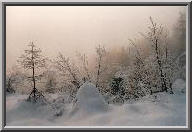 Winterstimmung.
A photo to relax your mind a bit --
a small impression from a
late afternoon descent from Kriska gora to Golnik, submerged in winter fog.
The photo was taken exactly at the few meters' boundary between the
valley dullness and the still bright evening sunshine just a few metres
above it. In conditions of the temperature inversion, it is surprising
how rapidly the mood changes when you go downhill or uphill.
Winterstimmung.
A photo to relax your mind a bit --
a small impression from a
late afternoon descent from Kriska gora to Golnik, submerged in winter fog.
The photo was taken exactly at the few meters' boundary between the
valley dullness and the still bright evening sunshine just a few metres
above it. In conditions of the temperature inversion, it is surprising
how rapidly the mood changes when you go downhill or uphill.
|
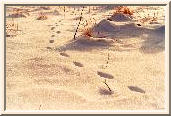 Rabbit's footprints.
Another one to ease your mind,
rabbit's footsteps in fresh snow
on the Planina Dol, an Alm above Kamniska bistrica in the Kamniske Alps.
From this spot, there is an interesting view of the neighbouring
mountains of Kosutna, Kompotela and of some of the villages down under.
This tiny, seemingly dull Alm, reachable even by car during summer
months (but I recommend you don't do it and go on foot instead),
hosts an interesting bunch of creatures, mostly jumping around
during the night or early morning hours. But even afterwards, when
human creatures start to jump aroud, their traces remain, an eternal
source of Christmas card motives.
Rabbit's footprints.
Another one to ease your mind,
rabbit's footsteps in fresh snow
on the Planina Dol, an Alm above Kamniska bistrica in the Kamniske Alps.
From this spot, there is an interesting view of the neighbouring
mountains of Kosutna, Kompotela and of some of the villages down under.
This tiny, seemingly dull Alm, reachable even by car during summer
months (but I recommend you don't do it and go on foot instead),
hosts an interesting bunch of creatures, mostly jumping around
during the night or early morning hours. But even afterwards, when
human creatures start to jump aroud, their traces remain, an eternal
source of Christmas card motives.
|
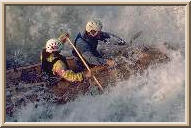 White water experience.
Another one to unease your mind a bit,
a picture taken at Tacen, the only artificial white-water racing course
in our country, and in the last decade also the site of many kayak
and canoe competitions, including the World Championships.
But there are a few other popular spots where you can bang your head
against solid rock while pumping up your adrenaline level...
White water experience.
Another one to unease your mind a bit,
a picture taken at Tacen, the only artificial white-water racing course
in our country, and in the last decade also the site of many kayak
and canoe competitions, including the World Championships.
But there are a few other popular spots where you can bang your head
against solid rock while pumping up your adrenaline level...
|
 6th Triglav lake.
Just after its founding, the Triglav national park
was first limited to the valley of the seven Triglav lakes that
follow one another in a neat sequence in a gentle slope of a few
kilometres length. Today, this valley forms the core of a larger
area which is protected as a territory of special national importance.
The seven small lakes always fascinated people by their incredible
green-blueish colour. Sadly, especially the 6th (shown here)
and the 5th Triglav lakes that lie near the main mountain
hut, are already heavily polluted and I'm not sure how much of this
wonderful colour is still OK and how much is not. In any case,
bathing is already discouraged by the officials. The picture here,
however, was taken in late October, when the lake starts to rest
for a few months and recovers somewhat.
6th Triglav lake.
Just after its founding, the Triglav national park
was first limited to the valley of the seven Triglav lakes that
follow one another in a neat sequence in a gentle slope of a few
kilometres length. Today, this valley forms the core of a larger
area which is protected as a territory of special national importance.
The seven small lakes always fascinated people by their incredible
green-blueish colour. Sadly, especially the 6th (shown here)
and the 5th Triglav lakes that lie near the main mountain
hut, are already heavily polluted and I'm not sure how much of this
wonderful colour is still OK and how much is not. In any case,
bathing is already discouraged by the officials. The picture here,
however, was taken in late October, when the lake starts to rest
for a few months and recovers somewhat.
 5th Triglav lake.
Another photo of
the nearby twin lake (you might call it a pond, but we
call it a lake, I suppose because it is so dear to us) and at about
the same time of year. The reflections on the water surface belong
to the ridge of Ticarica and Zelnarica that rise vertically a few
hundred metres just above the main valley. This (a bit brittle) ridge is
rarely visited, since the valley trail in the immediate vicinity of the
lakes attracts far more visitors. However, I can assure you that
the view from there is just plain great, despite the fact that
you have to dedicate some of it to pathfinding.
5th Triglav lake.
Another photo of
the nearby twin lake (you might call it a pond, but we
call it a lake, I suppose because it is so dear to us) and at about
the same time of year. The reflections on the water surface belong
to the ridge of Ticarica and Zelnarica that rise vertically a few
hundred metres just above the main valley. This (a bit brittle) ridge is
rarely visited, since the valley trail in the immediate vicinity of the
lakes attracts far more visitors. However, I can assure you that
the view from there is just plain great, despite the fact that
you have to dedicate some of it to pathfinding.
 4th Triglav lake.
The 4th Triglav lake
(I really never figured it out in which
direction one should count them) is the largest lake in the Valley of the
seven lakes. It is also called `The Kidney' for its peculiar
kidney- or bean-like shape. The photo was taken somewhen in
April, when the snow slowly and ice start to melt. All Triglav lakes
freeze during the winter, when even the frequently visited valley
that holds them rests for a while. When winter and spring months
bring plenty of snow and rain, you might encounter some of the
footpath markings you used to see on the rocks you pass, under
transparent covers of water ice (but such winters became somewhat rare
these days...).
4th Triglav lake.
The 4th Triglav lake
(I really never figured it out in which
direction one should count them) is the largest lake in the Valley of the
seven lakes. It is also called `The Kidney' for its peculiar
kidney- or bean-like shape. The photo was taken somewhen in
April, when the snow slowly and ice start to melt. All Triglav lakes
freeze during the winter, when even the frequently visited valley
that holds them rests for a while. When winter and spring months
bring plenty of snow and rain, you might encounter some of the
footpath markings you used to see on the rocks you pass, under
transparent covers of water ice (but such winters became somewhat rare
these days...).
 Cerknica lake.
The photo shows an intermittent lake
in the southwestern part of Slovenia.
The Cerknica lake has numerous underground sources and drains that
fill and empty the lake in a weird mechanism, event today only
partially understood. Our natural historian, scholar and explorer,
the baron J. Vajkard Valvasor, who accomplished most of his research
enterprises from the back of his horse, even became a member of the
Royal Society in London for studies of the complex mechanisms behind
this curious lake. Today, the Cerknica lake is maybe better known
for the neighbouring town of Cerknica and its Carnival, and for its
nearby mountain of Slivnica, where yelling witches ride their brooms
(not only for the Carnival). It is also popular among windsurfers.
Cerknica lake.
The photo shows an intermittent lake
in the southwestern part of Slovenia.
The Cerknica lake has numerous underground sources and drains that
fill and empty the lake in a weird mechanism, event today only
partially understood. Our natural historian, scholar and explorer,
the baron J. Vajkard Valvasor, who accomplished most of his research
enterprises from the back of his horse, even became a member of the
Royal Society in London for studies of the complex mechanisms behind
this curious lake. Today, the Cerknica lake is maybe better known
for the neighbouring town of Cerknica and its Carnival, and for its
nearby mountain of Slivnica, where yelling witches ride their brooms
(not only for the Carnival). It is also popular among windsurfers.
 Source of Kamniska bistrica.
The little and rather cold
source of Kmaniska bistrica, a small river
that carved an interesting gorge downstream, is easily accesible by car
from Kamnik. There is even a mountain hut here with reasonable
good food, an especially tasty apple strudel and refreshing beer.
The lower, friendlier part of the Kamniska bistrica area is a popular
Sunday trip for many people and you can see them wandering through the
forests till late afternoon.
However, beware of ticks!
They inhabit this area in zillions and trillions!
Source of Kamniska bistrica.
The little and rather cold
source of Kmaniska bistrica, a small river
that carved an interesting gorge downstream, is easily accesible by car
from Kamnik. There is even a mountain hut here with reasonable
good food, an especially tasty apple strudel and refreshing beer.
The lower, friendlier part of the Kamniska bistrica area is a popular
Sunday trip for many people and you can see them wandering through the
forests till late afternoon.
However, beware of ticks!
They inhabit this area in zillions and trillions!
 Winterstimmung.
A photo to relax your mind a bit --
a small impression from a
late afternoon descent from Kriska gora to Golnik, submerged in winter fog.
The photo was taken exactly at the few meters' boundary between the
valley dullness and the still bright evening sunshine just a few metres
above it. In conditions of the temperature inversion, it is surprising
how rapidly the mood changes when you go downhill or uphill.
Winterstimmung.
A photo to relax your mind a bit --
a small impression from a
late afternoon descent from Kriska gora to Golnik, submerged in winter fog.
The photo was taken exactly at the few meters' boundary between the
valley dullness and the still bright evening sunshine just a few metres
above it. In conditions of the temperature inversion, it is surprising
how rapidly the mood changes when you go downhill or uphill.
 Rabbit's footprints.
Another one to ease your mind,
rabbit's footsteps in fresh snow
on the Planina Dol, an Alm above Kamniska bistrica in the Kamniske Alps.
From this spot, there is an interesting view of the neighbouring
mountains of Kosutna, Kompotela and of some of the villages down under.
This tiny, seemingly dull Alm, reachable even by car during summer
months (but I recommend you don't do it and go on foot instead),
hosts an interesting bunch of creatures, mostly jumping around
during the night or early morning hours. But even afterwards, when
human creatures start to jump aroud, their traces remain, an eternal
source of Christmas card motives.
Rabbit's footprints.
Another one to ease your mind,
rabbit's footsteps in fresh snow
on the Planina Dol, an Alm above Kamniska bistrica in the Kamniske Alps.
From this spot, there is an interesting view of the neighbouring
mountains of Kosutna, Kompotela and of some of the villages down under.
This tiny, seemingly dull Alm, reachable even by car during summer
months (but I recommend you don't do it and go on foot instead),
hosts an interesting bunch of creatures, mostly jumping around
during the night or early morning hours. But even afterwards, when
human creatures start to jump aroud, their traces remain, an eternal
source of Christmas card motives.
 White water experience.
Another one to unease your mind a bit,
a picture taken at Tacen, the only artificial white-water racing course
in our country, and in the last decade also the site of many kayak
and canoe competitions, including the World Championships.
But there are a few other popular spots where you can bang your head
against solid rock while pumping up your adrenaline level...
White water experience.
Another one to unease your mind a bit,
a picture taken at Tacen, the only artificial white-water racing course
in our country, and in the last decade also the site of many kayak
and canoe competitions, including the World Championships.
But there are a few other popular spots where you can bang your head
against solid rock while pumping up your adrenaline level...